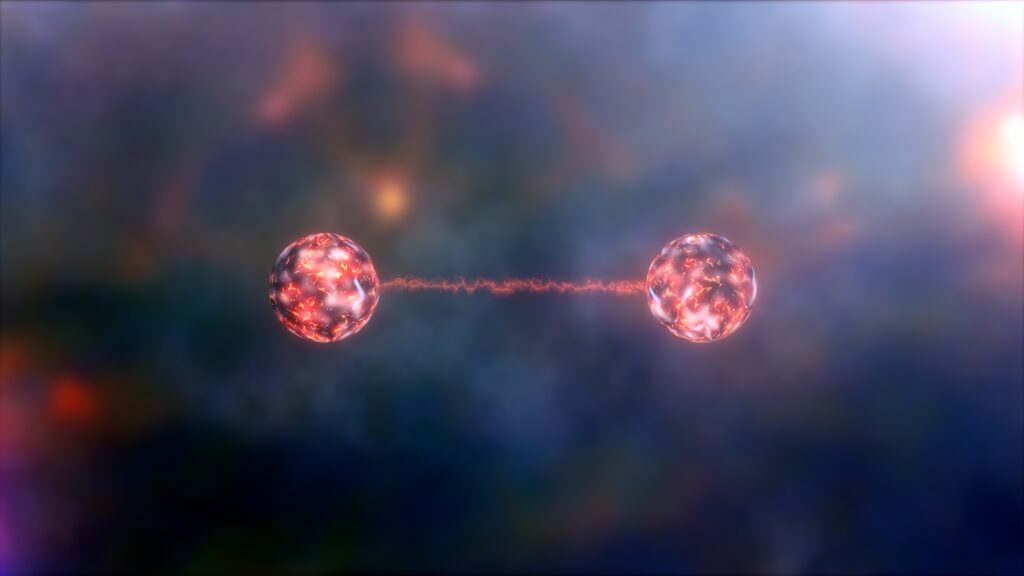What lurks behind spacetime?
Reading | Physics
![]() Bernardo Kastrup, PhD, PhD | 2022-01-12
Bernardo Kastrup, PhD, PhD | 2022-01-12

The cosmic riddle of structure without extension—of how complexity can exist outside space and time—is tackled by our Executive Director in this first edition of our Mid-Week Nugget.
Long gone are the days in which spacetime was regarded as an immutable, absolute, irreducible scaffolding of nature. Although our ordinary intuitions still insist on this outdated notion, since the late 18th century a series of developments in philosophy and science—such as Kant’s and Schopenhauer’s proposal that spacetime is a mere category of perception, Einstein and his block universe, Julian Barbour and his universe without time, Lee Smolin and his universe without space, loop quantum gravity, etc.—have relegated it to the status of persistent illusion. Spacetime is but a relatively superficial layer of nature contingent upon more fundamental underlying processes.
The problem is that spacetime seems to be a prerequisite for differentiation and, by implication, structure. Things and events can only be distinguished from one another insofar as they occupy different volumes of space or different moments in time. Without spaciotemporal extension, all of nature would seem to collapse into a singularity without internal differentiation and, therefore, without structure. Schopenhauer had already seen this in the early 19th century, when he argued that spacetime is nature’s principium individuationis, or ‘principle of individuation.’
Yet, it is empirically obvious that nature does have structure: its very regularities of behavior betray just that. Under certain circumstances nature does one thing and, under others, something else; repeatedly and reliably. Such distinguishable and consistent behaviors can only occur with some form of underlying, immanent structure.
So how are we to reconcile the empirical fact that nature has structure with the understanding that spacetime is not fundamental? How are we to think of the irreducible foundations of nature as both lacking extension and having structure? I submit that this is the least recognized and discussed dilemma of modern science.
To solve it, we must start with an admission: objects and events do indeed inherently require spaciotemporal extension to be differentiated; Schopenhauer was right about the principium individuationis. But we know of one other type of natural entity whose intrinsic structure does not require extension.
Consider, for instance, a hypothetical database of student records. Each record contains the respective student’s intellectual aptitudes and dispositions, so the school can develop an effective educational workplan. The records are linked to one another so to facilitate the formation of classes: students with similar aptitudes and dispositions are associated together in the database. Starting from a given aptitude, a teacher can thus browse the database for compatible students.
Now, notice that these associations between records are fundamentally semantic: they represent links of meaning. Associated records mean similar or compatible aptitudes, which in turn mean something about how students naturally cluster together. Therein lies the usefulness of the database. Even though it may have a spatiotemporal embodiment—say, paper files stored in the same box in an archive—there is a sense in which their structure fundamentally resides in their meaning. Spaciotemporal embodiments merely copy or reflect such meaning. After all, the semantic relationships between my intellectual aptitudes and those of others wouldn’t disappear if our respective paper files went up in flames.
I submit that this is how we must think of the most foundational level of nature, the universe behind extension: as a database of natural semantic associations, spontaneous links of meaning. This is similar to how a mathematical equation associates variables based on their meaning, whether such associations happen to have spatiotemporal embodiments or not. The associations can indeed be projected onto spacetime—just as databases can have physical embodiments—but, in and of themselves, they do not require spacetime to be said to exist. This is how nature can have structure without extension.
But what about causality? Its central tenet is that effect follows cause in time, so what are we to make of it without extension? Philosopher Alan Watts once proposed a metaphor to illustrate the answer: imagine that you are looking through a vertical slit on a wooden fence. On the other side of the fence, a cat walks by. From your perspective, you first see the cat’s head and then, a moment later, the cat’s tail. This repeats itself consistently every time the cat walks by. If you didn’t know what is actually going on—that is, the existence of the complete pattern called a ‘cat’—you would understandably say that the head causes the tail.
Behind extension, the universe is the complete pattern of semantic associations—that is, the cat. Our ordinary traversing of spacetime is our looking through the fence, experiencing partial segments of that pattern. All we see is that the cat’s tail consistently follows the cat’s head every time we look. And we call it causality.
The notion that, at its most fundamental level, nature is a complete pattern of associations has been hinted at by physicists before. Max Tegmark, for instance, has proposed that matter is mere “baggage,” the universe consisting purely of abstract mathematical relationships.
We must, however, avoid vague abstract handwaving: every mathematical structure ever devised has existed in a mind, not in an ontic vacuum. The only coherent and explicit conception of mathematical objects is that of mental objects. To speak of mathematical structure without a mind is like talking of the Cheshire Cat’s grin without the cat. Unless you are Lewis Carroll, you won’t get away with that.
Meaning—such as those of the variables in a mathematical equation—is an intrinsically mental phenomenon. In the absence of spacetime, this betrays the only possible ontic ground of a cosmic semantic database: the universe is a web of semantic associations in a field of spontaneous, natural mentation; for mind is the only ontic substrate we know of that isn’t indisputably extended.
Indeed, dispositions and aptitudes are palpably real—in the sense of being known through direct acquaintance—yet transcend extension. What is the size of my aptitude for math? What is the length of my disposition to philosophize, or even of my next thought? Whatever theory of mind you subscribe to, the pre-theorical fact remains: you can’t take a tape measure to my next thought; mentation is not indisputably extended.
As such, within the bounds of coherent and explicit reasoning, a structured universe without irreducible extension is per force a mental universe—not in the sense of residing in our individual minds, but of consisting of a field of natural, spontaneous mental activity, whose intrinsic ‘dispositions’ and ‘aptitudes’ are known to us as the ‘laws of nature.’

Essentia Foundation communicates, in an accessible but rigorous manner, the latest results in science and philosophy that point to the mental nature of reality. We are committed to strict, academic-level curation of the material we publish.
Recently published
Reading
Essays
Seeing
Videos
Let us build the future of our culture together
Essentia Foundation is a registered non-profit committed to making its content as accessible as possible. Therefore, we depend on contributions from people like you to continue to do our work. There are many ways to contribute.















